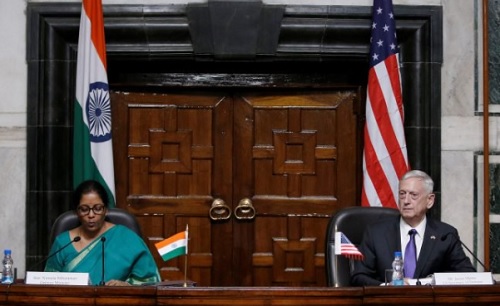Secretary of State Rex Tillerson will visit India this week to “dramatically deepen” economic and military relations, partly to counter China’s negative influence in Asia. India has been a particularly vocal opponent of China’s Belt and Road Initiative, while China invests in India’s neighbors such as Pakistan, Nepal, and Sri Lanka. India has criticized China’s unclear lending terms, which forces countries that cannot pay back their loans to transfer critical infrastructure ownership to Chinese ventures. China and India also have a seven-decades-long border dispute, which experiences periodic flare ups.
China and India also exhibit competitive tendencies in regional influence, marked by the recent standoff at Doklam and continued naval competition in the Indian Ocean.

India’s Defence Minister Nirmala Sitharaman (L) speaks as US Defense Secretary Jim Mattis looks on during a joint news conference in New Delhi, India September 26, 2017. REUTERS/Adnan Abidi
For these reasons, the United States has sought deeper defense cooperation with the world’s largest democracy. Most recently, Secretary of Defense James Mattis laid the groundwork for deeper defense ties between the US and India during his September trip to India, including the potential sale of US Unmanned Aerial System Drones and fighter jets to India.
But the United States should be wary about too strongly aligning with India on current issues in the Sino-Indian relationship for three critical reasons.
1) The United States does not want to get dragged into a war with China.
Admittedly, the US-Indian relationship is far from an alliance, but it is critical to avoid entrapment dynamics. Conflict could occur between China and India along the border, and not necessarily as a result of Chinese assertiveness. Perhaps due to the historical legacy of the Chinese surprise attack in 1962, India often engages in hyperbolic thinking about Chinese capabilities and intentions along the border. While India sees China as a rival, China does not put the same amount of attention and resources toward competition with India.
In short, Chinese behavior is often the result of strategic calculations about national interest and less about countering or undermining Indian influence in the region. This type of rivalry dynamic is not something the United States wants to exacerbate or be a part of.
2) Indirect support may be more effective at enhancing stability in the region than direct support.
Specifically, if the United States and India enter into some sort of military partnership, or the United States becomes deeply enmeshed in building up the Indian military, this may create more backlash than indirect support, such as in the form of arms sales or joint exercises. However, both forms could enhance Indian military capabilities, thereby increasing deterrence against China on the ground. This is because there is a higher threshold for India than other countries in terms of what they can do militarily before eliciting a Chinese response.
3) Deepening defense ties with India won’t solve the strategic challenge of the rise of China.
India has neither the capabilities nor the will to serve as an effective balance against China’s growing influence in South Asia and military might in the region. India’s history of non-alignment makes Delhi a difficult strategic partner. On top of that, India does not have the resources to engage on the level and with the frequency that is necessary to build an effective coalition. Even if we overcame these bureaucratic, political and economic challenges, improved Indian force posture will not be sufficient to compel China to divert resources away from strategically critical areas like the South China Sea.
This article first appeared in the American Enterprise Institute
Leave Comments